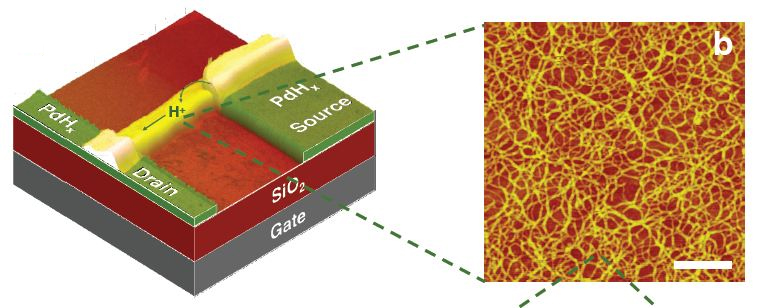Breakthrough: proton-based chips that communicate directly with living things
September 21, 2011 by Amara D. Angelica

Biocompatible maleic-chitosan nanofibers (yellow) embedded in a field effect transistor. A potential difference applied across source and drain generates a proton current to flow along the maleic chitosan. A potential applied onto the gate modulates the proton current. This modulation occurs by inducing more or fewer protons onto the maleic chitosan via capacitive coupling. (Credit: University of Washington)
University of Washington scientists have just crossed another major threshold between humans and machines: they’ve built a transistor that uses protons instead of electrons.
Their ultimate goal: create devices that can communicate directly with living things certain biological functions that involve protons — eventually even control them — a “first step toward ‘bionanoprotonics‘.”
Yes, there are implants (such as cochlear implants and other prosthetics), but they are not chips, and they communicate using electrons, negatively charged particles. And electrons don’t interface well with living things, which use protons (positively charged hydrogen atoms) or ions.
In the body, protons activate “on” and “off” switches and are key players in biological energy transfer. They open and close channels in the cell membrane to pump things in and out of the cell (proton pumps in the stomach lining that turn on acid for example). The body also uses these protons to flex muscles and transmit brain signals. If a machine could sense proton currents, it could sense biological signals directly, and if it could generate proton currents, it could even control certain functions directly.
Chitosan: an interface between transistors and tissue
Turns out there’s a way to do that. “We found a biomaterial, chitosan, that is very good at conducting protons, and allows the potential to interface with living systems,” said Marco Rolandi, a UW assistant professor of materials science and engineering. The UW scientists incorporated chitosan in a prototype field-effect transistor (includes a gate, drain, and source terminal for the current). This is the first such device to use protons, they say. It measures about 5 microns wide, roughly a twentieth the width of a human hair, small enough to be implanted.
The UW device uses a modified form of chitosan (maleic-chitosan), which is created from chitin, the structural element in the exoskeleton of crustaceans (such as crabs and shrimp). The material is compatible with living things, is easily manufactured, and can be recycled from crab shells and squid pen discarded by the food industry. The researchers discovered that this form of chitosan works remarkably well at moving protons. The chitosan absorbs water and forms many hydrogen bonds; protons are then able to hop from one hydrogen bond to the next.
Applications in the next decade or so, Rolandi said, would likely be for direct sensing of cells in a laboratory. The current prototype has a silicon base and could not be used in a human body. Longer term, however, a biocompatible version that supports other types of ions (besides protons) could be implanted directly in living things to monitor — or even control — certain biological processes directly, the scientists say.
Brain implants and beyond
So what does this mean for implants for the brain and other organs? Well, imagine a new class of (hypothetical) biocompatible memristors that could be embedded — even woven into — neural circuits, sensing and supplementing neural functions, connected to computers. This could have major implications for treating neural disorders like Parkinson’s, for example, or rewiring around circuits damaged by stroke or Alzheimer’s, or for cardiac problems, or control of prosthetic devices connected to an arm or leg for quadriplegics, or to allow locked-in patients in a coma to communicate.
Further in the future, it may even allow for reverse-engineering the brain or uploading the brain to a computer. (There are also some scary implications — think remote mind control.) I’m just speculating here, but stay tuned, this is going to get really interesting….
Ref.: Chao Zhong, et al., A polysaccharide bioprotonic field-effect transistor, Nature Communications, 2011; [DOI:10.1038/ncomms1489]
UPDATE 9/21/2011 T 5:15 a.m. PDT: Marked text removed and diagram caption expanded.